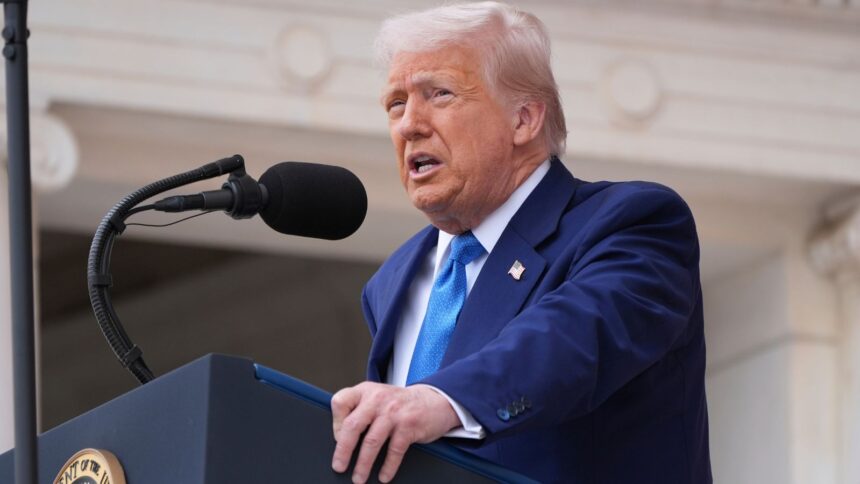Hours after US President Donald Trump’s sweeping tariffs on goods imported into America from almost every nation was ruled illegal by the US Court of International Trade, an appeals court – the Federal Circuit Court in Washington, DC that has jurisdiction over the trade court – on Thursday temporarily halted the decision, reinstating the levies for now. Its order said that it would grant the Trump administration’s request for an immediate administrative stay, and gave the plaintiffs — a group of 12 states and five US-based companies — until June 5 to respond to the administration.
Judicial Process
As the Trump administration’s appeal works its way through the American courts, what is clear is that this case will probably end up at the US Supreme Court at some point in the near future.
The three judge panel at the US Court of International Trade, which included one Trump appointee, had ruled unanimously that the statute the White House used, known as the International Emergency Economic Powers Act or IEEPA – does not grant the American President the authority to impose tariffs with a really wide scope as were levied through Trump’s reciprocal tariffs on practically all major trading partners of the US. They said in the ruling that the emergency economic powers legislation (IEEPA) does not give “unbounded tariff authority” to the President, and that the statute can only be used for unusual and extraordinary threats. Trade deficit, they said, does not really fit that definition.
At the same time, there are sector specific tariffs that the Trump administration slapped on steel, aluminum, cars and car parts etc, under a different statute known as Section 232, which could be used in the near future for things such as semiconductors and pharmaceuticals too. Those were all imposed citing national security reasons, and were distinct from the tariffs under IEEPA. Those can all stay in place for the moment, and there is a chance that the Trump administration would now use provisions such as Section 232 to impose such sector-specific tariffs on countries, especially if the Federal Circuit court were to also rule against the IEEPA levies.
What needs to be kept in mind is that apart from this case at the International Trade Court filed by the dozen other states and some small businesses, there is another high-profile case in California from the Democrat Governor Gavin Newsom arguing that Trump’s trade tariffs were illegal. This, according to legal experts, is the case to watch out for.
Ensuing Uncertainty
In the meantime, what is unclear is whether business should ultimately plan for relief if the trade court’s ruling stands, or whether the tariffs might stick. That raises the real question about whether the so-called reciprocal tariffs due in July will ever come into effect, whether the 10 per cent universal tariff can stay, whether the US Congress will come to the president’s rescue, and what the final judgement of the Supreme Court will be. This course will decide whether nations need to negotiate for deals with the US.
And during the appeals process, the Trump administration could seek alternate routes to deploy additional tariffs, according to experts. This could add to the uncertainties. The earlier ruling halting the imposition of the levies serves to undermine ongoing attempts by the US Treasury Secretary Scott Bessent to negotiate trade deals with other countries, including India.
The UK is looking somewhat imprudent in having already rushed into a trade deal with the US, which retains the 10 per cent base rate that was part of Trump’s original plan. This is despite the US have a trade surplus with the UK. Others such as Japan and the European Union were already holding back, after seeing the Trump administration beat a retreat amid an upheaval in the US government borrowing rates. The legal uncertainty is a further reason for countries to wait and watch.
With negotiators from the US set to arrive in New for trade talks on June 5-6, officials in the Ministry of Commerce and Industry said they are “studying the implications” of the US Court of International Trade’s Wednesday ruling. Trump had on April 2 announced a steep 26 per cent reciprocal tariff on India, despite New Delhi agreeing to commence negotiations with Washington on a trade deal. The tariffs were paused till July 8, and the Indian government is keen to sign an interim trade deal before that. The legal developments, though, could warrant a recalibration now.
Legal experts are of the view that the Trump administration could have a weak case, especially when it comes to the question of law on IEEPA. Constitutionally, in America, trade policy is the domain of the US Congress and the chairs of the Trade committees of the House and Senate (branches of the Ways and Means Committee) are typically very powerful positions. President Trump bypassed all of that by proclaiming a variety of national emergencies. While he has some scope to act in actual emergencies, under powers ceded by the US COngress to the White House over the decades, these two specific cases contend that the sweeping use of these powers to announce permanent tariff changes was illegal and unconstitutional. That could hold water. The Court of International Trade ruling appears rather robust from that perspective, and also emboldens California’s similar case.
For now, it would be prudent to expect other negotiators around the world to put their feet up and wait, while the White House tries to prove the legality of the very basis of its global trade onslaught.








